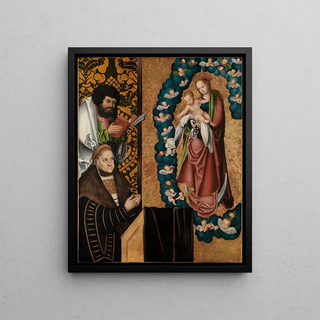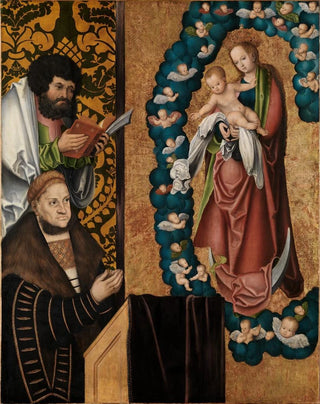Art print | Frédéric le Sage devant la Mère de Dieu - Lucas Cranach l'Ancien


View from behind

Frame (optional)
Frédéric the Wise before the Madonna - Lucas Cranach the Elder – Captivating Introduction
In the vibrant universe of German Renaissance painting, the artwork "Frédéric the Wise before the Madonna" stands out for its spiritual depth and narrative richness. Created by Lucas Cranach the Elder, this piece is much more than a simple religious representation; it embodies a meeting between the sacred and power. The painting, which alludes to the devotion of Duke Frederick III of Saxony, bears witness to an era when art served as a conduit for faith and politics. By contemplating this work, viewers are invited to immerse themselves in a world where historical figures and spiritual themes intertwine, creating an atmosphere of intimacy and reverence.
Style and uniqueness of the work
Cranach's style is characterized by fine execution and a palette of delicate colors that captivate the eye. In "Frédéric the Wise before the Madonna," the meticulous details of the costumes, as well as the expressions of the figures, reveal impressive technical mastery. The contrast between the majesty of the Virgin and the humble posture of the duke highlights a visual hierarchy that reinforces the spiritual message of the piece. The faces, imbued with an almost supernatural serenity, seem to invite meditation. Every element, from the drapery to the accessories, is carefully designed to create a visual harmony that transcends mere decoration. This work also stands out for its symbolic use of light, which illuminates the scene while emphasizing the divine nature of the Madonna.
The artist and his influence
Lucas Cranach the Elder, an emblematic figure of the Renaissance, knew how to leave his mark through prolific and diverse artistic production. As an artist serving the court, he skillfully combined the political expectations of his patrons with a unique artistic sensitivity. His ability to depict historical figures while endowing them with a spiritual dimension made him a pioneer in religious portraiture. Influenced by the humanist ideas of his time, Cranach also played a key role in spreading the ideas of the Reformation, notably through his works that defended the

Matte finish

View from behind

Frame (optional)
Frédéric the Wise before the Madonna - Lucas Cranach the Elder – Captivating Introduction
In the vibrant universe of German Renaissance painting, the artwork "Frédéric the Wise before the Madonna" stands out for its spiritual depth and narrative richness. Created by Lucas Cranach the Elder, this piece is much more than a simple religious representation; it embodies a meeting between the sacred and power. The painting, which alludes to the devotion of Duke Frederick III of Saxony, bears witness to an era when art served as a conduit for faith and politics. By contemplating this work, viewers are invited to immerse themselves in a world where historical figures and spiritual themes intertwine, creating an atmosphere of intimacy and reverence.
Style and uniqueness of the work
Cranach's style is characterized by fine execution and a palette of delicate colors that captivate the eye. In "Frédéric the Wise before the Madonna," the meticulous details of the costumes, as well as the expressions of the figures, reveal impressive technical mastery. The contrast between the majesty of the Virgin and the humble posture of the duke highlights a visual hierarchy that reinforces the spiritual message of the piece. The faces, imbued with an almost supernatural serenity, seem to invite meditation. Every element, from the drapery to the accessories, is carefully designed to create a visual harmony that transcends mere decoration. This work also stands out for its symbolic use of light, which illuminates the scene while emphasizing the divine nature of the Madonna.
The artist and his influence
Lucas Cranach the Elder, an emblematic figure of the Renaissance, knew how to leave his mark through prolific and diverse artistic production. As an artist serving the court, he skillfully combined the political expectations of his patrons with a unique artistic sensitivity. His ability to depict historical figures while endowing them with a spiritual dimension made him a pioneer in religious portraiture. Influenced by the humanist ideas of his time, Cranach also played a key role in spreading the ideas of the Reformation, notably through his works that defended the






